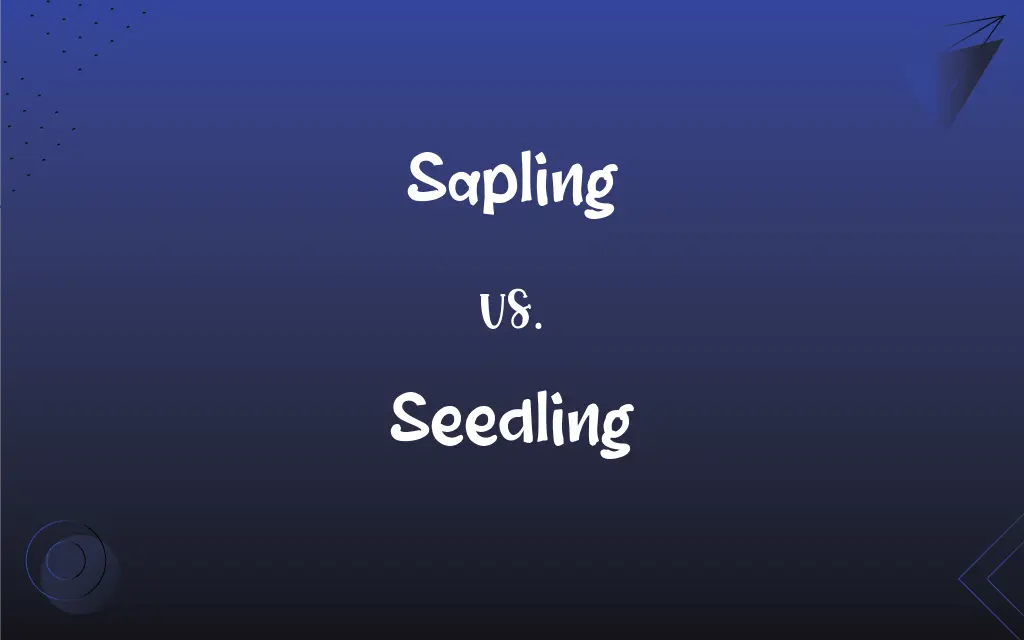Sapling vs. Seedling: What's the Difference?
Edited by Aimie Carlson || By Janet White || Published on February 28, 2024
A seedling is a young plant grown from a seed, typically recently sprouted, while a sapling is a slightly older, young tree, more developed than a seedling.

Key Differences
A sapling is a young tree in its early stages of growth, larger and more developed than a seedling. A seedling, in contrast, is a very young plant that has just emerged from a seed, usually displaying its first leaves.
Saplings have a more established structure, with a small trunk and several branches. Seedlings are much smaller, often with just a shoot and embryonic leaves, lacking a true stem or branches.
A sapling, due to its size and age, is generally more robust and can withstand environmental stresses better than a seedling. Seedlings are delicate and more susceptible to environmental factors like drought or high winds.
The sapling stage follows the seedling phase and can last for several years as the tree grows larger. The seedling phase is relatively short, typically lasting only until the plant establishes its first true leaves.
Saplings contribute to the regeneration of forests and ecosystems, gradually growing into mature trees. Seedlings represent the earliest stage of plant growth and are critical for the continuation of plant species.
ADVERTISEMENT
Comparison Chart
Growth Stage
Young tree, more developed than seedling
Very young plant, recently sprouted
Physical Characteristics
Small trunk, several branches
Shoot with embryonic leaves
Durability
More robust, withstands stress better
Delicate, vulnerable to environmental factors
Time Period
Lasts several years
Short phase, until first true leaves develop
Ecological Role
Contributes to forest regeneration
Critical for species continuation
ADVERTISEMENT
Sapling and Seedling Definitions
Sapling
Sapling refers to a small, young tree, more developed than a seedling.
We planted a sapling last year, and it's growing rapidly.
Seedling
A seedling is a young plant grown from a seed.
The tomato seedlings are ready to be transplanted into the garden.
Sapling
Saplings are young trees that have surpassed the seedling stage.
The forest was filled with saplings, showing signs of new growth.
Seedling
Seedling refers to the earliest growth stage of a plant.
Each seedling in the greenhouse will become a beautiful flower.
Sapling
A sapling is a stage in a tree's life before it reaches maturity.
Each sapling in the garden represents a future canopy tree.
Seedling
A seedling is characterized by a shoot and embryonic leaves.
The seedlings sprouted their first true leaves a week after germination.
Sapling
A sapling is characterized by a small trunk and initial branches.
The apple sapling has started to sprout its first branches.
Seedling
A seedling is the young plant stage following germination.
These seedlings will grow into herbs for the kitchen garden.
Sapling
A sapling is a young tree in the early stages of growth.
The oak sapling in the backyard is finally tall enough to provide shade.
Seedling
Seedlings represent the initial phase of a plant's life cycle.
We carefully water the seedlings daily to ensure their growth.
Sapling
A young tree.
Seedling
A young plant, especially one that grows from a seed, rather than from a cutting, for example.
Sapling
A youth.
Seedling
(botany) A young plant grown from seed.
Sapling
A young tree, bigger than a seedling.
Seedling
Any young plant, especially:
Sapling
(figuratively) A youngster, especially a male nearing maturity.
Seedling
One grown in a nursery for transplanting.
Sapling
A young tree.
Seedling
A tree smaller than a sapling.
Sapling
Young tree
Seedling
A plant reared from the seed, as distinguished from one propagated by layers, buds, or the like.
Seedling
Young plant or tree grown from a seed
FAQs
What is the main difference between a sapling and a mature tree?
Saplings are smaller and less developed compared to mature trees.
Can saplings survive harsh conditions?
Saplings are more robust than seedlings but still need care to survive extreme conditions.
How long does a tree remain a sapling?
A tree can be a sapling for several years until it reaches a more mature stage.
Are saplings important for reforestation?
Yes, saplings play a crucial role in the reforestation process.
What defines a sapling?
A sapling is a young tree, larger and more developed than a seedling.
What is the typical lifespan of a seedling?
The seedling stage is short, lasting until the plant develops its first true leaves.
Can seedlings be transplanted easily?
Seedlings can be transplanted, but they require careful handling due to their fragility.
How fragile are seedlings?
Seedlings are delicate and vulnerable to environmental stresses.
Can saplings grow in pots?
Saplings can grow in pots but eventually need to be transplanted as they grow larger.
What care do seedlings need?
Seedlings need protection from harsh sunlight, regular watering, and gentle handling.
Do saplings require a lot of water?
Saplings require adequate water but less than seedlings, which need constant moisture.
How do you identify a sapling?
A sapling can be identified by its small trunk and the beginning of branch development.
How fast do seedlings grow?
Seedling growth rate varies depending on species and environmental conditions.
Do all plants start as seedlings?
Most plants start as seedlings, though some can propagate through other means.
What challenges do seedlings face in the wild?
In the wild, seedlings face challenges like competition, herbivory, and climatic factors.
How can you support sapling growth?
Providing adequate space, water, and protection from damage supports sapling growth.
What is a seedling?
A seedling is a very young plant that has recently sprouted from a seed.
Are saplings affected by pests?
Saplings can be susceptible to pests, though typically less so than seedlings.
Why are seedlings important in agriculture?
Seedlings are the starting point for most agricultural crops.
Why do gardeners start plants as seedlings?
Starting plants as seedlings allows for controlled growth conditions and better survival rates.
About Author
Written by
Janet WhiteJanet White has been an esteemed writer and blogger for Difference Wiki. Holding a Master's degree in Science and Medical Journalism from the prestigious Boston University, she has consistently demonstrated her expertise and passion for her field. When she's not immersed in her work, Janet relishes her time exercising, delving into a good book, and cherishing moments with friends and family.
Edited by
Aimie CarlsonAimie Carlson, holding a master's degree in English literature, is a fervent English language enthusiast. She lends her writing talents to Difference Wiki, a prominent website that specializes in comparisons, offering readers insightful analyses that both captivate and inform.
































































